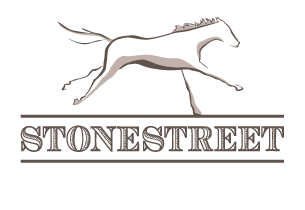Each year from January to June, Kentucky’s Bluegrass region serves as the birthplace for thousands of Thoroughbreds. While our mares and foals will receive a breakfast and lunch daily, the lion’s share of their nutrients will come from the grass they eat in their pastures. In this blog, we’ll get to the ‘root’ of how we maintain our pastures to nourish future racehorses.
The Bluegrass region sits atop the oldest exposed bedrock in the state of Kentucky, which is comprised of thick limestone. This sediment is a remnant of the Middle Ordovician period when ocean waters covered much of North America. Limestone acts as a natural fertilizer by boosting the soil’s reserves of essential elements such as nitrogen, phosphorous, calcium, and potassium. Soil testing is conducted at Stonestreet in the summer to determine the levels of each of these elements. The results will form the basis of our pasture management plan.
Our goal as managers is to ensure that nitrogen, phosphorous, calcium, and potassium are present in the desired levels as they each play crucial roles. Nitrogen controls the quantity and quality of grass growth. Phosphorous and calcium are essential for bone formation in horses. They also aid in grass growth. Phosphorus aids in early grass growth by providing key nutrients while calcium helps to maintain chemical balance in the soil, reduces soil salinity, and improves water penetration. Last but certainly not least, potassium aids in the durability and palatability of our pastures. Potassium adds sugar to the grass to make it more appealing for the horses. It also aids the grass in withstanding stresses such as heat, drought, disease, and insects. We are careful to ensure that the levels of each element are balanced. Too much or too little of any one element will have a negative effect on both the grass and the horses.
In addition to the nutrient levels of our pastures, we also test for the soil’s pH. Key nutrients are depleted in strongly acidic soils due to leeching, and their absence has a negative effect on both the grass and our horses. If soil testing determines that an area of the pasture is too acidic, we add lime to raise its pH. The word “lime” refers to products derived from pulverized limestone. This mineral provides calcium and magnesium for the plants and improves both water penetration and the uptake of major nutrients. A desirable pH falls between 6.2 and 6.8.
With our key elements balanced and our pH at a desirable level, our maintenance crews can get to work. We have covered mowing, aerating, and chain harrowing in previous entries in our How to Build a Racehorse series, so for more information on each of these procedures, you can revisit our earlier blog entries.
Seeding boosts the levels of desirable grasses such as bluegrass, orchard grass, and ryegrass in our paddocks while also limiting the effects of our horse’s patch grazing. Horses are finicky grazers and will repeatedly eat in the same areas and create fallow spaces. We seed in the spring and fall to ensure that the grass has the optimal environment to grow.
One botanical nuisance in Kentucky pastures is tall fescue. Fescue poses no threat to horses in small amounts, but when it reaches a certain percentage, it can cause serious issues for our pregnant mares. These issues include dystocias or difficult births, prolonged gestation, and late-term pregnancy loss. We do our best to keep fescue from germinating in our fields as it is very difficult to eliminate. In order to keep fescue out, we populate our fields with desirable grasses and few weeds. Fescue grows in the barren ground left by patch grazing. We reduce patch grazing by controlling the number of horses in a given field. We also fertilize, lime, and overseed our pastures to keep a hearty population of those desirable grasses.
Pasture maintenance is a year-round endeavor that ensures our horses have the best tools to succeed. The verdant pastures of Stonestreet Farm provide them with the foundation they need to win at the highest level at the racetrack.
